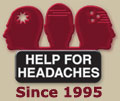Reprinted with permission from the American Council for Headache Education (ACHE) by Alan Stiles, DMD
Everyone who suffers from headaches desires improvement, wheather this means taking less medication, experiencing fewer side effects, obtaining pain relief more rapidly, or making fewer visits to the doctor. Most patients with headaches continue to keep their eyes and ears open for new and better therapies that could be the answer to their longlasting battle against the next headache attack.
Unfortunately for headache suferers, many gimmicks exist that prey upon their hopes for better treatment. Dental appliances that claim efficiancy in treating all sorts of head, neck or facial pain have been around for years.The headache sufferer needs to be armed with enough knowledge to make an informed decision about whether these appliances are gimmicks or legitamate treatment options.
Within the past few years, a group of dental appliances has been marketed for headache sufferers. With countless appliances in existance, singling out one or two would be unfair. These appliances are generally known as an anterior deprogrammer, an anterior tooth separating appliance, an anterior bite plate, a muscle deprogramming device, and a removable anterior jig appliance. They are designed to fit on the upper front teeth and mechanically prohibit the upper and lower back teeth from contacting. This type of appliance was first introduced in the mid 1900s as the Lucia jig. It has since been modified numerous times and remarketed in a variety of ways. It was first used in reconstructive dentistry to help establish a bite position to which restorative work could be done, and it is used for this same purpose today. This appliance has gained recognition in treating pain through clever marketing campaigns that exaggerate their efficacy not through rigorous scientific testing.
Manufacturers market these appliances to both patients and doctors. Attractively designed websites lure patients with enticing claims of effectiveness. The manufacturers claim that their appliances help patients who "have head, neck or facial pain, have been diagnosed with migraine, tension-type or cluster headache, have sore or tight jaws in the morning, have to take medications repeatedly for their headaches, have been under treatment by their doctor without long term relief, have sinus-or allergy-related headaches, have eye strain and have had their eyes checked". If the appliances worked for all those ailments, then almost everyone reading this article would be a candidate for this treatment.
The makers of the dental appliances also target the doctors who could recommend the appliances to their patients. They promote the products as "practice builders", in other words as a way to increase revenues for their practice. The manufacturers may supply instructional videos, CD ROMs, forms that can be filled out and placed in the patients' charts, training for staff, and free billing information. Some even supply incentive plans wherein the physician is rewarded with discounts or money back for the number of appliances delivered or for the number of completed forms faxed back to the company.
Based on limited evidence that oral appliances can be effective for reducing the incidence of migraine headaches, the Food and Drug Administration (FDA) has approved the marketing of some of these appliances for diagnosing and even treating headaches. Warning! The approval process for medical devices (which included dental appliances) is entirely different from that required for medications. Before approving a medication, the FDA requires multiple trials in animals and in humans. With medical devices, however, the approval process is much less strigent, and new devices that are similar to previously approved devices can apply for the same FDA approval. Most of the appliances being marketed for headaches are categorized as "jaw repositioning devices", and a wide variety of appliances carry this FDA approval.
Although the mechanisms of migraine are not fully understood, it is believed that migraine is an inherited disorder of the brain that produces a sensitive central nervous system that sometimes becomes over-reactive and results in a migraine attack. An area of the brainstem known as "the migraine generator" has been identified as being crucial in intiating a migraine attack. This area is a relay station for information passing to and from the face and head and the brain. It is believed that too much activity passing through this area may trigger a migraine attack.
One of the goals of a migraine preventive agent or therapy is to reduce the activity in this area of the brain. Muscular activity of the head (including the muscles of the jaw) may increase the activity through this area. Dental appliances reduce muscular activity and, therefore, may reduce some of the activity through the generator. Muscular activity is only one of many signals that are carried through this area, and although decrerasing excessive muscular activity may have a positive effect on headache frequency, it is certain not a cure.
The claim that any device (or medication) is a headache cure-all should be taken with a grain of salt. When properly used, dental appliances can be part of an integrated headache management approach. The reasons for use, the realistic expectations, and the potential risks of any appliance should be discussed thoroughly with your headache doctors.
Published on the Help For Headaches Web Site http://www.headache-help.org

